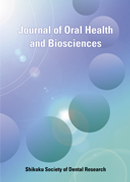31 巻, 1 号
選択された号の論文の10件中1~10を表示しています
- |<
- <
- 1
- >
- >|
総説(教授就任記念)
-
2018 年 31 巻 1 号 p. 1-12
発行日: 2018年
公開日: 2018/07/05
PDF形式でダウンロード (3794K)
原著論文
-
2018 年 31 巻 1 号 p. 13-24
発行日: 2018年
公開日: 2018/07/05
PDF形式でダウンロード (1340K) -
2018 年 31 巻 1 号 p. 25-31
発行日: 2018年
公開日: 2018/07/05
PDF形式でダウンロード (1327K) -
2018 年 31 巻 1 号 p. 32-38
発行日: 2018年
公開日: 2018/07/05
PDF形式でダウンロード (1034K) -
2018 年 31 巻 1 号 p. 39-48
発行日: 2018年
公開日: 2018/07/05
PDF形式でダウンロード (2571K)
基礎教育講演
-
2018 年 31 巻 1 号 p. 49-56
発行日: 2018年
公開日: 2018/07/05
PDF形式でダウンロード (734K)
臨床指導講演
-
2018 年 31 巻 1 号 p. 57-61
発行日: 2018年
公開日: 2018/07/05
PDF形式でダウンロード (4127K) -
2018 年 31 巻 1 号 p. 62-67
発行日: 2018年
公開日: 2018/07/05
PDF形式でダウンロード (1127K) -
2018 年 31 巻 1 号 p. 68-72
発行日: 2018年
公開日: 2018/07/05
PDF形式でダウンロード (1491K)
報告
-
2018 年 31 巻 1 号 p. 73-77
発行日: 2018年
公開日: 2018/07/05
PDF形式でダウンロード (1614K)
- |<
- <
- 1
- >
- >|
